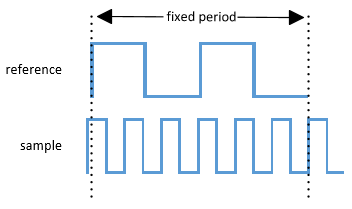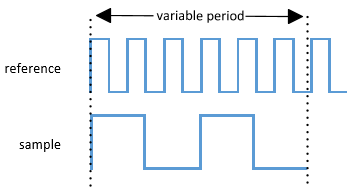
How Frequency Counters work
The executive summary is that a frequency counter works by counting the edges of the unknown frequency as well as the edges of an accurate reference over a fixed time period. Simple mathematics then tell you what the unknown frequency is, plus or minus an error term. There are a number of different methods for doing this, let’s take a look at them.
For the remainder of this article we will refer to the frequency being measured as the sample frequency and the accurate timebase as the reference frequency.
Direct frequency measurement
The direct frequency method counts the number of edges of the sample frequency observed during a fixed number of periods of the reference frequency.

The formula for calculating the sample frequency is straightforward.

N is the count, period is in Hz
From the above formula you can see that if the reference frequency is 1Hz then the measurement implementation becomes really simple as the number of sample counts observed is the sample frequency and could be output directly to an attached display.
Because the time period is linked to the reference frequency the error term for this method is ±1 tick of the sample clock, making the error term variable for an instrument built to use this method of counting.
Equal precision measurement
The equal precision (or reciprocal) method links the time period to an integer multiple of the sample clock. There is an excellent and very readable PDF available online that describes this method. Click here to read it.
The instrument receives a trigger to start counting pulses but does not do so until the next rising edge of the sample clock. It then starts counting both the reference and sample clock edges using two counters.

After the desired time period has come to an end the instrument stops counting at the next rising edge of the sample counter. The relationship between the time period, the two counters and their associated frequencies is given by the following ratios:

s and ref are the sample and reference signals
Discarding the period and re-arranging the remaining ratios gives us the following formula for calculating the sample frequency:

The advantage of this method is that the error term is ±1 tick of the reference clock and if the reference clock is high enough then the error term can be reduced to a very small value.








